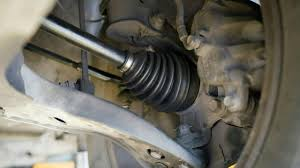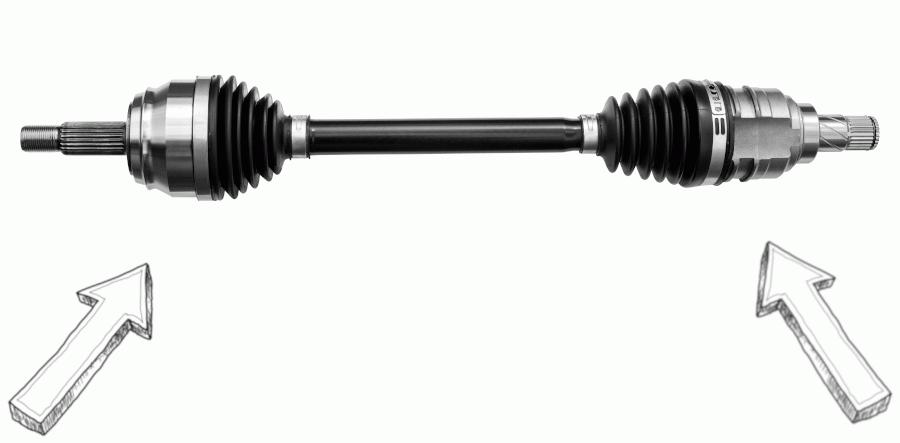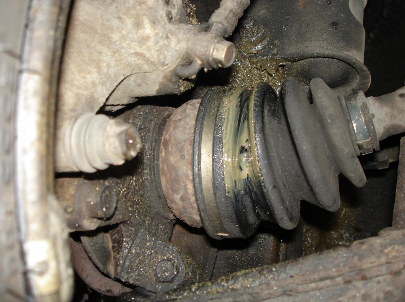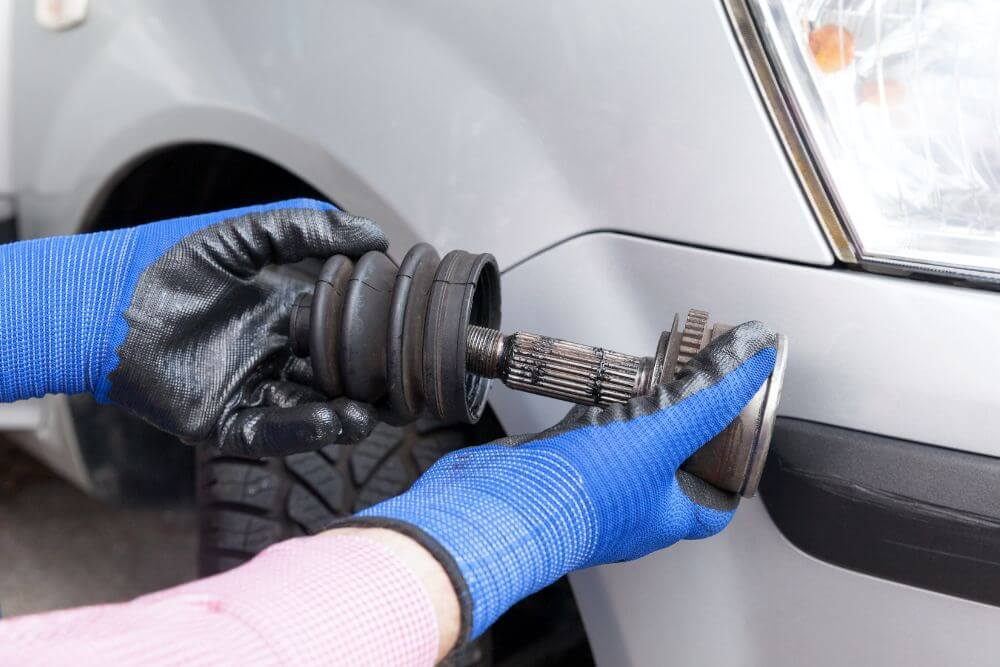OUTLINE:
Identifying Warning Signs of a Failing CV Joint
 120
120Hey, have you ever felt something wrong with the car while driving, such as a strange noise or slight shaking? At this time, you have to keep Dim sum, because this may be a signal that your car's universal joint is about to have a problem. Universal joint, in simple terms, is responsible for transmitting the power of the engine to the wheels, allowing the car to run smoothly. It's like a 'power transmission expert' for a car.

Image Source: CARFAX.com
However, just like humans, universal joints also have moments of fatigue. Once it starts to 'tire', the car may start to have some 'temper tantrums'. For example, you may hear some strange noises or feel a slight shaking of the car while driving. These are all "tips" for possible problems with universal joints.
So, if your car has these 'little tips', don't take them lightly. Hurry up and find some time to check the condition of the universal joint. If there is really a problem, it must be dealt with in a timely manner, otherwise it will have a great impact on the safety and performance of the car. After all, safe driving is the responsibility of each and every one of us!
Quick Answer: What Is A CV Joint
CV Joint, also known as constant velocity universal joint, is a key component of the transmission system in a car. Its function is great, it can smoothly deliver power from the gearbox to the wheels, and it is also very flexible, allowing the suspension and steering systems to move freely.
This CV Joint is designed very cleverly. No matter which angle the wheels turn, it can maintain a smooth and consistent speed of rotation. This way, when we drive, the handling is particularly stable and feels very comfortable.
Generally speaking, this CV Joint is mainly installed on front wheel drive or four-wheel drive vehicles. It is like a bridge, connecting the transmission shaft and wheels. If it has a problem, the car may have abnormal noises, vibrations, and other issues, which can make driving uncomfortable and even affect safety.
So, we need to regularly check this CV Joint to see if there are any issues. If you find anything wrong, quickly find a professional car repair shop to fix it, so that our car can run steadily.
The Features&Function of A CV Joint

Image Source: D S Auto.com
Ball shaped CV joint: This type is commonly seen in front wheel drive vehicles, which relies on the ball inside to adapt to changes in angle, making the joint more flexible.
Tripod type CV joint: This is usually located on the side inside the axle, with three sliding rods that can move and withstand strong moments.
Let's talk about durability again:
CV joints are made of high-strength materials, which can withstand acceleration, braking, and turning.
Lubricate this area, it is filled with oil, which can reduce friction and wear, making the joints run smoother and more durable.
The protective cover is also quite important:
Each CV joint is covered with a rubber or plastic protective sleeve, which can prevent dust, water, debris, and keep oil inside.
In terms of functionality, the CV joint is also quite capable:
Power transmission: It can transfer the engine's power from the gearbox to the wheels, allowing the car to move forward and backward.
Flexible angle: When the suspension of the car moves or turns, it can adapt to changes in angle, ensuring that power can always be transmitted to the wheels without losing the chain.
Shock absorption: It can also reduce vibration, making driving more comfortable. It allows for slight misalignment and can absorb the impact of road roughness.
Direction control: It allows the wheels to turn to different angles when turning, making the car easier to drive and more stable, especially for front wheel drive and four-wheel drive vehicles.
Suspension movement compensation: It can also allow the suspension to move up and down, which is particularly important for maintaining grip and stability on uneven roads.
Symptoms of A Bad CV Joint[For Checking Purpose]

Image Source: Counter Magazine.com
Hey, if your CV joint (the universal joint on the car) is not right, you may have the following feelings or see these phenomena:
The sound of "click click" or "pop":
Especially when you are turning, if you hear this kind of sound, it's like the joints are ringing, it may be because the CV joint is almost dead, especially in sharp turns, the sound is more obvious, indicating that it has been worn out almost.
Oil leakage:
If you see oil stains inside or under the wheels, you have to be careful. It may be that the protective cover of the CV joint is broken and the oil is leaking out.
The car is shaking badly:
When driving, especially at high speeds, if you feel the car shaking abnormally, it may be a problem with the CV joint. This kind of shaking may be transmitted to the steering wheel, making you feel like the whole car is shaking.
Difficulty in steering:
If there is a lot of resistance or inability to turn when steering, it may be due to a problem with the CV joint, especially if there are other areas that are not working properly.
The wheels spin unnaturally:
If you find that the wheels are not turning smoothly or look a bit crooked, it may be due to the CV joint being at fault.
The sound of 'dong dong':
When accelerating or decelerating, if you hear a "thump" sound, it may be because the CV joint has been severely worn, especially when turning, the sound may be louder.
Uneven tire wear:
Although there are many reasons for uneven tire wear, if there is a problem with the CV joint, especially if it causes the tire to tilt, the tire wear will also become uneven.
The wheels lack strength:
If the CV joint really doesn't work, in severe cases it may cause one or more wheels to lose all strength, which can be a headache when driving.
Why Does A Clicking Noise Occur when Turning if the CV Joint Is Bad
If there is a problem with your CV joint (the car part that connects the wheels and driveshaft), you may encounter the following strange things:
Click click "or" pop "sound:
When you turn the steering wheel, especially when you turn it too quickly, you may hear this kind of sound, like joints ringing. This may be a signal of CV joint wear.
Oil leakage:
If you see oil on the side of the wheels or under the car, it may be because the protective cover of the CV joint is broken and the oil is leaking out.
The car is shaking anxiously:
When driving, especially at high speeds, if the car keeps shaking, it may be due to a problem with the CV joint. This kind of shaking may also spread to the steering wheel, making you feel like the whole car is shaking.
Difficulty in steering:
When turning the steering wheel, if you feel a lot of resistance and can't turn, it may be due to the CV joint causing trouble, especially if there are other strange phenomena.
The wheels are not rotating properly:
If you find that the wheels don't turn smoothly or look a bit crooked, it may be because the CV joint is playing tricks.
The sound of 'dong dong':
When stepping on the accelerator or brake, if you hear a "thump" sound, it may be due to severe wear on the CV joint, especially when turning, the sound may be louder.
Uneven tire wear:
There are many reasons for uneven tire wear, but if there is a problem with the CV joint, especially if it causes the tire to tilt, the tire wear will also become uneven.
The wheels lack strength:
If the CV joint really doesn't work, in severe cases it may cause one or more wheels to have no strength at all, and then driving can be a headache, feeling like the car has no strength to move forward.
What Happens if I Ignore the Symptoms of A Bad CV Joint
If you turn a blind eye to the problem of CV joints (the joints that maintain constant speed transmission in cars), your car may suffer and encounter a lot of trouble. The following are possible occurrences:

Image Source: The Auto Shop of Chapin
Regardless of the consequences of CV joint problems
The CV joint is completely destroyed:
Over time, worn or damaged CV joints may be completely scrapped. In this way, the faulty wheels will lose their strength and the car will not be able to move, and you may be stuck on the road.
Surging repair costs:
At first, it may just be a small matter of changing the CV joint, but if not dealt with quickly, the problem may become more and more serious, and there will be more areas that need to be repaired. A broken CV joint may affect other parts such as the axle, gearbox, or suspension system, which increases the repair cost.
The car is difficult to control:
Problems with the CV joint can affect the handling and stability of the vehicle. In this way, steering may become difficult or unpredictable, increasing the risk of accidents, especially when turning or suddenly changing lanes.
Tire wear and misalignment:
If there is a problem with the CV joint, it may cause the tires to be misaligned or worn unevenly, so you need to change the tires in advance. If this issue is ignored, it may also affect the fuel consumption and overall performance of the car.
Involve surrounding components:
Once the CV joint is damaged, nearby parts such as wheel bearings and suspension components may be subjected to greater pressure. In this way, it may cause further damage and make repairs more expensive.
hidden danger:
The problem with the CV joint is a major hidden danger, which may result in sudden loss of grip or inability to turn properly. In this way, the possibility of accidents increases, and drivers and other pedestrians on the road will be very dangerous.
FAQs: How much Does It Cost to Replace A Bad CV Joint
How much does it cost to replace a faulty CV joint (the joint on a car that keeps the wheels spinning at a constant speed)? It depends on the situation, such as the brand and model of your car, the labor cost in your area, and whether you choose original parts or from another factory. Let me briefly explain how much it will cost:
Cost Details
Parts cost:
The price of the CV joint itself is generally between $50 and $150. But if the entire CV axis needs to be replaced (which is a common situation), each axis may cost $100 to $300.
Labor cost:
The labor cost for replacing a CV joint may range from $100 to $200 per hour, or even more, depending on the repair shop and region. Replacing a CV joint usually takes 1.5 to 3 hours, so the labor cost may be $150 to $600.
Total cost:
Adding up the parts and labor, replacing a CV joint would cost around $300 to $800. If both CV joints on the front axle need to be replaced, the cost may be higher, costing over $1000.
Other things to consider
Warranty: Check if your car is still under warranty. If it is, it may save money on repairs.
Repair shop prices: The prices of 4S stores and private repair shops may differ significantly, so it's best to ask more and compare prices.
Region: Labor costs in cities may be higher than in rural areas.
Other repairs: If other parts (such as the protective sleeve or shaft of the CV joint) are also damaged, it may cost more.
The End
In conclusion, recognizing the warning signs of a failing CV joint—such as clicking noises during turns, grease leakage, vibrations, and steering difficulties—is crucial for maintaining your vehicle's safety and performance. Promptly addressing these symptoms can prevent further damage and costly repairs. If you suspect an issue with your CV joint, consult a qualified mechanic to ensure your vehicle remains in optimal condition.

Disclaimer: The views and opinions expressed by individual authors or forum participants on this website do not represent the views and opinions of Chipsmall, nor do they represent Chipsmall's official policy.

share this blog to:

